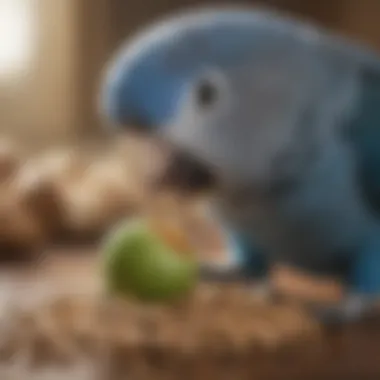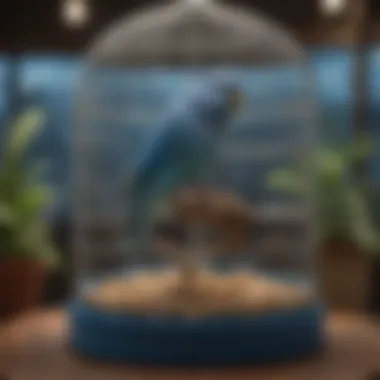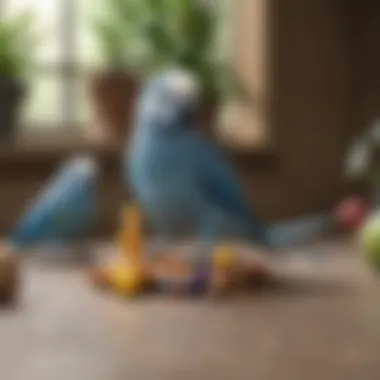The Blue Parakeet at PetSmart: A Guide for Future Owners


Intro
The blue parakeet, also known as the budgerigar or budgie, often captures the hearts of bird enthusiasts and casual pet owners alike. Its vibrant plumage and sociable nature make it a popular choice among those looking to introduce a feathered friend into their homes. However, the decision to bring a blue parakeet into your life, particularly through a retail outlet like PetSmart, involves more than just falling for its charming appearance. This article aims to provide a well-rounded exploration of the essential aspects of owning a blue parakeet.
Understanding Your Pet
Pet Behavior Basics
Understanding the behavior of a blue parakeet is crucial for establishing a happy relationship with them. Budgies are naturally social creatures and thrive in the company of others. They exhibit various behaviors, such as chirping, playing, and preening, which are signs of a healthy and content bird. With proper socialization and interaction, these birds can develop strong bonds with their owners.
Common Breed Characteristics
Blue parakeets are fascinating both in appearance and temperament. The blue coloration can vary from a light sky blue to a more vibrant shade. In terms of personality, they display intelligence and playfulness. Most budgies are curious and enjoy exploring their environment. They can be trained to perform tricks and mimic sounds, which adds to their appeal as pets.
Species-Specific Needs
Owning a blue parakeet requires an understanding of their specific needs. They need ample space to fly and play. A suitable cage should be at least 18 inches wide, 18 inches deep, and 24 inches tall. Providing perches at different heights and toys to stimulate their minds is also essential. These birds require social interactions, along with proper care and attention.
Pet Care and Maintenance
Feeding Guidelines
A balanced diet for a blue parakeet is fundamental for its health. Quality seed mixes, fresh fruits, and vegetables should form the basis of their meals. Pelleted diets are an excellent option as well. It's important to regularly change their food to ensure freshness and to provide clean water every day. Certain foods, like avocado and chocolate, are toxic to budgies and must be avoided.
Grooming Essentials
Regular grooming is important for blue parakeets. This involves keeping their feathers clean and free of debris. Additionally, providing cuttlebones or mineral blocks can help maintain their beak's health. Nail trimming is also necessary, as overgrown nails can cause discomfort.
Hygiene Practices
Hygiene is crucial in maintaining the well-being of a blue parakeet. Clean the cage and replace the bedding frequently to prevent the buildup of waste. Regularly washing their food and water dishes contributes to their health and prevents the spread of bacteria.
Training and Development
Basic Commands and Skills
Training blue parakeets can be a rewarding experience. Start with simple commands such as 'step up' or 'come here.' Consistency and positive reinforcement are key. Using treats can motivate them to learn more commands and behaviors.
Behavioral Training Techniques
To address behavioral issues, like excessive screeching or feather plucking, a structured approach is necessary. Positive reinforcement can deter unwanted behaviors. Understanding triggers and providing the right environment can help mitigate these issues effectively.
Addressing Common Behavior Issues
Common problems include biting or aggressive behavior, usually arising from fear or lack of socialization. Gradual exposure to handling and interaction can help alleviate these behaviors over time. Identifying and addressing stress factors is an essential step in behavioral management.
Health and Wellness
Routine Vet Check-ups
Regular veterinarian visits are crucial for maintaining the health of your blue parakeet. It's advisable to schedule yearly check-ups to monitor their health and prevent potential issues.
Vaccination Needs
While budgies do not require vaccinations like dogs or cats, ensuring they are in a clean environment and free from diseases is important. Early detection of any health problems leads to better outcomes.
Recognizing Signs of Illness
Owners should familiarize themselves with signs of illness in blue parakeets. Changes in appetite, lethargy, or changes in vocalization can indicate health issues. Prompt attention to any unusual behaviors can help in catching diseases early.
Enrichment and Activities
Indoor vs.


Outdoor Activities
Balancing indoor play with outdoor opportunities is important for a blue parakeet's well-being. Indoor activities can include providing stimulating toys and free-flight time in a safe space. Outdoor experiences should always be supervised to protect against potential dangers.
Interactive Toys and Games
Interactive toys are essential to keep your blue parakeet engaged. Puzzle toys, mirrors, and swings can provide mental stimulation. Regular changes in the toy environment can help sustain their interest.
Socialization Opportunities
Encouraging socialization through interaction with other birds or active participation with family members is vital. This boosts their emotional health and reduces loneliness, which can drastically affect their behavior and overall well-being.
Prologue to Blue Parakeets
Understanding the blue parakeet is essential for potential owners considering this delightful bird as a pet. Their unique characteristics and colorful appearance make them particularly appealing. However, it is not just about looks. Awareness of their care requirements and behavioral traits is crucial. This section aims to prepare prospective owners by elucidating what it means to share a space with a blue parakeet. The deeper you delve into this species, the more you realize that informed ownership leads to a happier and healthier bird.
Defining the Blue Parakeet
The blue parakeet, a variant of the budgerigar, is part of the parakeet family, originating from Australia. These small to medium-sized birds are known for their vivid blue coloration, which varies based on genetic factors. Adult males usually display a bright blue cere, while females have a pale tan or brown cere. This physical distinction is essential for owners to identify the sex of their parakeet.
Blue parakeets are sociable and intelligent creatures. They thrive in environments where they can interact with humans and other birds. Their playful nature and capacity for mimicry make them captivating companions, indeed worth the commitment.
Common Variations and Genetics
The blue parakeet comes in numerous color variations, thanks to selective breeding. In essence, the genetics of these birds determine their feather coloration. The blue coloration results from a mutation in the birds’ pigmentation. Aside from the traditional blue, variations include sky blue, cobalt, and even violet shades. Understanding these variations helps potential owners choose the right parakeet while considering aesthetics and personality traits.
In addition to color, genetic factors can influence temperament, with some variations showing different behavioral traits. For instance, lavender budgerigars may have distinct social characteristics when compared to their cobalt counterparts. Therefore, having knowledge about genetics is an invaluable part of making a responsible and informed decision when acquiring a blue parakeet.
Characteristics of Blue Parakeets
Blue parakeets, commonly known as budgerigars or budgies, are popular pets known for their enchanting personalities and vibrant colors. Understanding their characteristics is critical for potential owners as it can significantly determine how well-fitting they are as a household companion. Their physical traits, behavior, and lifespan offer profound insights into what prospective owners should expect and prepare for.
Physical Traits
Blue parakeets possess distinct physical features that make them truly captivating. They typically have a slim body structure, measuring about 7 inches in length. The most striking characteristic is their bright blue plumage, which may vary in shade depending on genetics. Their wings are strong and equipped for flight, while their tails are elongated, often trailing behind them gracefully.
Their beaks are uniquely shaped; they are curved and are often yellowish or white. Male blue parakeets generally have a blue cere (the fleshy area above the beak), while females display more of a brown or beige color. This sexual dimorphism is an interesting aspect for owners to note when selecting a pet. Additionally, their small size allows for adaptable housing, which is ideal for various living situations.
Behavioral Patterns
Behaviorally, blue parakeets are lively and sociable creatures. They enjoy interaction, often forming strong bonds with their owners. Blue parakeets communicate through a variety of sounds and chirps. Those who spend time observing these birds will notice that they often mimic sounds, including human speech if they are taught. This ability to learn new sounds can bring joy to any household.
It is important for owners to engage with their parakeets regularly to maintain their socialization skills. They thrive in groups, showing a tendency to play and even display affection towards their companions. Observing these behaviors can help potential owners anticipate the dynamics involved in keeping a blue parakeet, especially in homes with children.
Lifespan and Longevity
The lifespan of blue parakeets is another vital factor to consider. On average, they live between 5 to 10 years, but with proper care, some individuals can exceed a decade. This longevity implies a commitment to their health and well-being. Regular veterinary check-ups can help detect potential health issues early. Additionally, providing a balanced diet, a stimulating environment, and ample social interaction has a significant impact on their overall longevity.
Proper care directly influences a blue parakeet’s lifespan, making responsible ownership essential for a fulfilling pet experience.
Understanding these characteristics allows prospective owners to reflect on their capacity to provide for a blue parakeet. Recognizing their physical traits, behavioral inclinations, and life expectancy shapes the decision-making process for anyone considering welcoming a feathery companion into their lives.
Caring for Blue Parakeets
Caring for blue parakeets is essential for their health and happiness, especially when considering the specific environment and diet that these birds require. Understanding how to provide the right living conditions, nutrition, and social interaction can significantly enhance the well-being of your parakeet. This section will delve into the fundamental aspects of parakeet care, emphasizing the importance of habitat, diet, and social needs to ensure that these vibrant birds thrive in your home.
Habitat Requirements
Space Considerations
Blue parakeets, being active and social creatures, need sufficient space to move about and exercise. The cage dimensions should allow them to spread their wings without restriction. A general rule of thumb is to aim for at least 18 inches wide, 18 inches deep, and 24 inches high.
Having an appropriate space can reduce stress and promote healthy behaviors. Enclosed environments that are too small can lead to frustration and may negatively impact their mental health. It's crucial to choose a cage that meets these criteria, as it can be a beneficial choice for both the bird and the owner. The spaciousness not only allows for movement but also provides room for perches, toys, and other enriching elements.
In this article, we will also explore how overcrowding or lack of space can lead to various behavioral issues and health risks for your blue parakeet.


Cage Design and Accessories
Selecting the right cage design is equally important for your blue parakeet's well-being. A cage should have horizontal bars, facilitating climbing, as well as various perches and toys to stimulate them mentally and physically. A well-designed cage includes several platforms and escape routes for your parakeet to navigate, providing them freedom of movement within a safe environment.
Choosing an appropriate cage size and accessories can enhance your bird's overall quality of life. For instance, providing toys that encourage chewing and problem-solving can keep a parakeet engaged. Consideration of external elements, like light sources and airflow, is also essential. However, a cage with too many accessories can sometimes create a cluttered environment, which could stress the birds. Balance is key to creating a suitable cage design.
Dietary Needs
Seed and Pellet Bases
A balanced diet for blue parakeets typically revolves around high-quality seed and pellet bases. The seed mixture should contain a variety of seeds to meet nutritional needs, providing essential vitamins and fatty acids. Pellets are often recommended as they are formulated to deliver balanced nutrition in a single source.
While seeds are a joyful and natural treat, relying solely on them may lead to imbalances in their diet. The key characteristic of having both seed and pellet bases is to ensure that your bird receives a well-rounded diet, preventing illnesses related to nutritional deficiencies.
It is important to monitor consumption, as blue parakeets can sometimes pick favored seeds, leading to an unbalanced diet. Maintaining a good mix of both can be beneficial for overall health.
Fresh Fruits and Vegetables
Incorporating fresh fruits and vegetables into a blue parakeet's diet is vital. Leafy greens such as kale and spinach, along with fruits like apples and berries, should be offered regularly. Fresh produce not only adds variety but also contributes essential vitamins and minerals necessary for their health.
The main benefit of including these fresh items is improving hydration levels, as many birds do not drink enough water. Regular introduction of fruits and vegetables helps maintain their weight and energy levels while offering stimulation for foraging behavior. However, it’s also essential to wash and cut these foods properly to avoid any potential hazards.
Social Interaction
Blue parakeets are inherently social animals. They thrive on companionship, whether from their fellow birds or their human caregivers. Engaging with your parakeet daily will help nurture a bond that strengthens their emotional health. Lack of social interaction can lead to boredom and depression. It's advisable to provide opportunities for playtime outside the cage under supervision to further encourage interaction.
Building trust takes time. Establishing a routine will aid in the gradual bonding process. By recognizing the social needs of blue parakeets, owners can contribute to a more enriched and fulfilling life for these spirited birds.
Important: Keeping multiple birds can also tackle social needs, but proper integration requires careful thought to avoid territorial conflicts.
Acquisition Considerations at PetSmart
In the journey of welcoming a blue parakeet into your life, understanding the avenues of acquisition is crucial. This section illuminates the nuances of acquiring a blue parakeet specifically from PetSmart. Here, we will analyze the merits and drawbacks of retail purchase, address the condition of animals, and clarify pricing and value considerations. Each of these discussions is intended to equip potential owners with the insight necessary for making a responsible decision.
Retail vs.
Adoption
When considering how to acquire a blue parakeet, the choice between retail purchase and adoption carries significant weight. Purchasing a blue parakeet from PetSmart offers immediate access to these birds, often with established brand guidelines on care and maintenance. PetSmart frequently provides essential information about each bird’s characteristics and needs, which can be beneficial for first-time owners.
However, adopting a blue parakeet from a shelter or rescue organization has its own advantages. Such birds may be in need of a loving home, and adopting can foster a sense of satisfaction that comes from giving a bird a second chance at life. Additionally, shelters may charge lower fees than traditional retail outlets. Adoption sometimes comes with the added benefit of prior behavioral assessment, which aids in matching the right bird with the right owner.
Ultimately, prospective owners should evaluate their priorities. If immediate acquisition and reliable support are crucial, PetSmart may be suitable. However, those seeking to help an animal in need might find that adoption serves their goals better.
Condition of Animals
In assessing any retail establishment, including PetSmart, it is essential to examine the condition of the animals available. Healthy blue parakeets typically exhibit vibrant colors, active behavior, and clear, bright eyes. Lack of these signs can indicate poor health or inadequate care. Potential owners should actively observe the following:
- Plumage: Look for shiny feathers without signs of plucking or discoloration.
- Behavior: Birds should be alert and responsive, not lethargic.
- Social Interaction: A healthy blue parakeet tends to show curiosity towards visitors and surroundings.
It is advisable to consult with the store staff about the bird's health history. PetSmart usually has protocols in place for veterinary checks, but always request to see any relevant health records.
Tip: Remember to trust your instincts. If a particular blue parakeet seems off, consider another option.
Pricing and Value Assessment
Cost is an important factor when acquiring a blue parakeet. Prices at PetSmart can vary based on the bird's age, health status, and coloration. On average, you can expect to pay anywhere from $50 to $150 for a blue parakeet. However, the cost of the initial purchase is only a fraction of the total investment needed for long-term care.
Consider the following when evaluating the full financial implications of your prospective pet:
- Initial Setup: Costs for cage, food, toys, and accessories can accumulate swiftly.
- Ongoing Care: Regular purchase of food, treats, and any necessary vet visits will impact your budget.
- Unexpected Expenses: Health issues can arise, leading to increased costs for treatment.
Being financially prepared ensures that your new feathered friend receives quality care throughout its life. At times, spending a bit more on a bird in better condition can pay off in terms of long-term health and happiness.
Health and Wellness of Blue Parakeets


Understanding the health and wellness of blue parakeets is crucial for potential owners. These small birds are very popular as pets. Knowing how to keep them healthy can lead to a much more rewarding experience as a pet owner. It is important to ensure that they live long, healthy, and active lives. When people consider adopting a pet, they often focus on appearance or behavior. However, health considerations should not be overlook.
Common Health Issues
Blue parakeets can face specific health challenges. Being aware of these issues helps in taking preventative measures.
Respiratory Problems
Respiratory problems are common in blue parakeets. This aspect is significant because respiratory health directly affects their quality of life. One key characteristic of these problems is their often subtle early signs. Owners might notice unusual sneezing or wheezing. It is beneficial to recognize these signs early. Early intervention can prevent serious complications.
Unique features of respiratory problems include their susceptibility to environmental factors. Drafts, poor air quality, or exposure to smoke can increase risk. Regular monitoring of bird environments is key.
Disadvantages can include the necessity of frequent veterinary visits. This can be time-consuming and costly. However, awareness and proactive care are important steps toward ensuring your bird’s wellness.
Nutritional Deficiencies
Nutritional deficiencies also pose a significant threat to blue parakeets. A balanced diet is vital for their overall health and longevity. A key characteristic of these deficiencies is their gradual onset. Often owners may not realize their birds are lacking essential nutrients until it's too late.
Specific nutrients such as calcium and vitamins A and D are particularly important. Blue parakeets who do not receive proper nutrition may experience growth issues or poor feather condition.
A unique feature of nutritional deficiencies is that they can often be managed easily with the right diet. Incorporating a variety of fresh fruits and vegetables can help. On the downside, some owners may find it challenging to consistently provide a balanced diet. Education on proper nutrition is beneficial for all parakeet owners.
Regular Veterinary Care
Regular veterinary care is essential for maintaining a blue parakeet's health. Routine check-ups can help catch issues before they become serious. A qualified avian veterinarian can provide invaluable guidance. Vaccinations and health assessments help ensure birds are in good condition.
Moreover, regular veterinary visits can educate owners on handling and caring for their pets. Knowing the signs of sickness or distress can mean the difference between a quick recovery versus extended health issues. Regular care contributes to a happier and healthier life for blue parakeets. Proper health management fosters a lasting bond between birds and their owners.
Training and Socialization
Training and socialization are essential components of caring for blue parakeets. These processes significantly impact the bird's behavior and overall well-being. By instilling good habits through training, owners can foster a harmonious relationship with their pets, while socialization helps them adapt to their environment. Understanding these aspects can enhance the experience of owning a blue parakeet.
Basic Commands
Teaching basic commands not only provides structure for your parakeet but also helps in building trust. Common commands include "step up," which encourages the bird to climb onto your hand or finger, and "step down," for instructing the bird to return to its perch or cage. Training sessions should be short, often lasting only a few minutes. Regular repetition is crucial. Here are some tips:
- Use positive reinforcement by offering treats, like millet or small pieces of fruit, when the parakeet follows your command.
- Remain patient; birds may take time to understand.
- Use a consistent tone of voice to establish familiarity.
- Repeat commands during daily interactions to reinforce learning.
Being attentive during the training process will also help identify individual learning styles. Some birds may respond better to visual cues, while others may lean towards auditory signals. This adaptability can make training more effective.
Creating Positive Environments
A positive environment is critical for the mental and physical health of blue parakeets. It should be stimulating yet safe. Here are some suggestions for creating a nurturing setting:
- Provide a spacious cage: This allows for free movement. Blue parakeets need room to fly and play.
- Include toys: Rotate different types of toys to keep your parakeet engaged. Chewing, climbing, and foraging toys can greatly enrich their lives.
- Social interaction: Regular interaction with humans and, if possible, other birds becomes part of their socialization. This helps them feel secure and builds confidence.
- Safe spaces: Designate quiet areas for rest where they feel secure. This can help minimize stress.
A well-structured training and socialization approach helps your blue parakeet thrive, offering it a better quality of life.
Establishing a positive environment combined with effective training enables blue parakeets to flourish as companions. This fosters not only obedience but also a sense of security, making them enjoyable pets.
End on Owning a Blue Parakeet
Owning a blue parakeet can be a rewarding experience, yet it requires careful consideration. This conclusion synthesizes key points about the commitment involved and highlights the specific benefits that these birds can bring into a household.
Evaluating Suitability as a Pet
Before acquiring a blue parakeet, potential owners must evaluate their suitability for this species. Several factors contribute to this evaluation:
- Time Commitment: Blue parakeets are social creatures that thrive on interaction. Owners must dedicate time each day for bonding and playing.
- Space Requirement: These birds need adequate space to move around. A suitable cage and a safe environment for out-of-cage time are essential.
- Family Dynamics: Assess how household members, particularly children, will interact with the pet. Not all families may be prepared to handle and care for a live animal.
Taking these factors into account ensures that a blue parakeet will fit well into your home environment. Owners should ask themselves if they can meet the needs of the bird both in terms of space and time.
Long-term Commitments and Responsibilities
Owning a blue parakeet is a long-term responsibility that goes beyond just feeding and caring for the animal. Consider the following commitments:
- Lifespan Awareness: Blue parakeets can live for 10 years or more with proper care. Prospective owners should be ready for a long-term commitment.
- Health Care Needs: Regular veterinary visits are important to maintain their health. Potential owners should find a vet experienced with avian care.
- Social Needs: These birds require daily social interaction to prevent loneliness and behavioral problems. Neglect in this area can lead to stress for the parakeet.
In summary, owning a blue parakeet involves significant long-term efforts. Understanding the responsibilities is essential for a healthy, happy bird and fulfilling ownership experience.
Remember: The joy of having a blue parakeet stems from the relationship you build with your feathered friend. Take the time to reflect on these considerations before making your decision.







